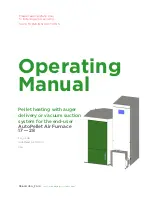
exemple, H4 followed by 3 means heating at 40% with
300 CFM.
9.5
FAULT CODE RESET
To clear the fault code memory, push and hold the Fault
Recall Button for more than 5 seconds and less than 10
seconds. The display will energize horizontal upper and
lower segments for four seconds. This will clear faults in
the buffer displayed at power-up.
9.6
DIAGNOSTIQUE FEATURES
The control continuously monitors its own operation and
the operation of the system. If the failure is internal to
the control, the entire control should be replaced, as the
control is not field repairable.
If the sensed failure is in the system (external to control),
the control will show error codes. Refer to table 17 for
diagnostic.
9.7
SEQUENCE OF OPERATION
The heating cycle is always initiated by a 24 volt signal
on W of the thermostat. When the controller senses 24
volts on W or the communicated message for heat call,
the following sequence occurs:
• High and low pressure switches are checked to
insure contacts are open.
• Pre-purge.
There are two different types of pre-purge; a normal
pre-purge and a learning-sequence pre-purge. During
a learning-sequence pre-purge, the inducer motor will
incrementally increase in RPM (stepping) until the low
and high pressure switches are both closed. After both
switches are sensed to be closed, the inducer motor will
continue to run for an additional 30 seconds before the
ignition trial.
A learning sequence pre-purge will be initiated under the
following conditions:
• First heat call after power reset.
• Every 25th heat call.
• Next heat attempt after a failed pre-purge (pressure
switch (es) does not close).
• Next
heat
attempt
after
a
pressure
switch
has opened unexpectedly during normal heating
operation.
A normal pre-purge will not go through the incremental
stepping process of the inducer motor and should be
much quicker. The inducer will start at a pre-determined
RPM (determined during learning-sequence pre-purge)
and this should close both pressure switches quickly.
Once both pressure switches are sensed to be closed,
the inducer will run for 25 seconds before the ignition trial
starts.
• Hot-surface igniter is energized during the pre-
purge period.
• The modulating gas valve is set to the highest
possible rate (no flow yet).
• The main solenoids on the gas valve are energized
allowing gas to flow to the burners.
• When flame is proven, the ignition control is de-
energized - 8 second maximum trial times.
• The gas valve maintains 90% rate through the
warm-up period - 20 seconds (aka «Blower On
Delay»).
9.8
SETTING INPUT RATE
Checking furnace input is important to prevent over firing
beyond its design-rated input.
Prior to checking the
furnace input, make certain that all other gas appliances
are shut off, with the exception of pilot burners. Refer to
section 6.2.
The furnace is shipped from the factory with #48 orifices.
They are sized for natural gas having a heating value of
1030 BTU/cu. ft. and a specific gravity of .64.
Since heating values vary geographically, the manifold
pressure may need to be changed. Consult the local gas
utility to obtain the yearly average heating value.
9.9
120 VAC TERMINALS
These terminals supply 120 VAC to the furnace control.
Spare terminals are provided for use with electronic air
cleaners and other accessories as needed (Check the
voltage rating of your equipment.)
9.9.1
Electronic air cleaner EAC (E103)
This output is used to energize an electronic air cleaner.
The output will provide 1.0 amp at 120 VAC. This output
is energized any time the blower motor is above 40% of
maximum airflow capacity. Airflow below this value is
not considered to be enough for a typical electronic air
cleaner to perform properly.
For ½ HP and ¾ HP motors – Electronic air cleaner is
energized any time the blower is above 320 CFM
For 1 HP motors - Electronic air cleaner is energized any
time the blower is above 800 CFM
9.9.2
HUM terminal
HUM terminal is only energized when blower is energized
in heating.
9.10
COMMUNICATIONS L.E.D.
“RX” (Green) L.E.D.
– This L.E.D. indicates that
communications is being sensed to or from (i.e.:
something on the network is trying to communicate) other
26
Summary of Contents for CC15-M-V
Page 18: ...Figure 17 Wiring Diagram 18...
Page 23: ...Figure 25 Direct vent clearance 23...
Page 24: ...Figure 26 Other than Direct vent clearance 24...
Page 34: ...12 PART LIST Figure 27 Exploded view...
Page 35: ...Figure 28 Exploded view continued...
Page 36: ...Table 19 Part list Chinook Compact...
Page 37: ...Table 20 Part list continued...
Page 38: ...13 NOTES 38...
Page 39: ...39...
Page 40: ...40...















































